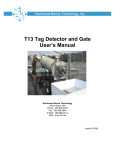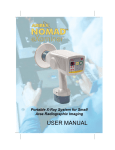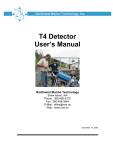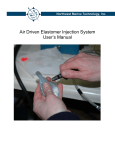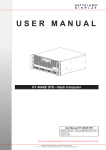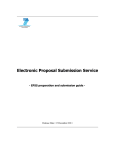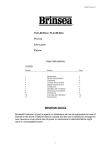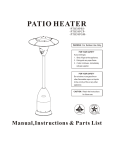Download T4 Detector for Coded Wire Tags User`s Manual Stand
Transcript
Northwest Marine Technology, Inc. T4 Detector for Coded Wire Tags User’s Manual Stand-Alone Version Northwest Marine Technology Shaw Island, WA Phone: 360-468-3375 Fax: 360-468-3844 E-Mail: [email protected] Web: www.nmt.us September 2005 Table of Contents Introduction.................................................................................... 3 1. Equipment Description and Setup ............................... 4 T4 Detector, stand-alone ........................................................................................... 4 T4 Detector ................................................................................................................ 5 Front Panel............................................................................................................. 5 Rear Panel ............................................................................................................. 5 Legs ........................................................................................................................... 7 Sling ........................................................................................................................... 8 T4 Detector Attachment to Legs ................................................................................ 9 Fish Funnel .............................................................................................................. 10 Connectors and Plugs.............................................................................................. 12 Power Supply........................................................................................................... 13 Battery...................................................................................................................... 13 Power Supply and Battery Setup ............................................................................. 14 Beeper Box .............................................................................................................. 15 Detection Standard .................................................................................................. 16 2. Equipment Operation................................................... 17 T4 Detector .............................................................................................................. 17 Power....................................................................................................................... 17 Beeper Box .............................................................................................................. 18 Fish Funnel .............................................................................................................. 19 Tag Detection........................................................................................................... 20 Radio Frequency Interference ................................................................................. 20 Magnetic Interference .............................................................................................. 20 3. Troubleshooting........................................................... 21 4. Maintenance ................................................................. 22 Care of the T4 Detector ........................................................................................... 22 Cleaning ............................................................................................................... 22 Disinfection........................................................................................................... 22 Disassembly............................................................................................................. 22 5. Service and Shipping................................................... 23 Transit Case............................................................................................................. 23 7. Equipment Specifications ........................................... 24 8. Contacting NMT............................................................ 25 9. Index.............................................................................. 26 T4 User’s Manual 2 Introduction The T4 is the first and smallest of a new line of tunnel-type Coded Wire Tag (CWT) detectors. It maintains the high sensitivity of the earlier R-Series detectors and their ability to detect a tag in any orientation while improving upon the water resistance and general ruggedness of those units. The T4 can operate as a stand-alone detector, with a diverter gate, or as a Quality Control Device (QCD) for a MKIV tag injector. The T-Series detectors are designed to plug together with one or more other system components such as a beeper box, power supply, control box, and an automatic diverter gate using a new unified system connector. Most components have two identical 8-pin connectors with universal cables to interconnect them. The T4 detector’s tunnel has inside dimensions of 2 1/4 inches (5.7cm) by 3 7/8 inches (9.8 cm). It may be used with either the broad or the narrow dimension upright, the NMT funnel is designed for attaching to the detector when the larger dimension is vertical. The T4 stand-alone tag detector is supplied with an audible beeper (beeper box). The beeper box has a power ON light and will beep and light two red LEDs when a tag is detected. The T4 detector may be powered from the NMT 24VDC power supply which has an input AC voltage range from 100-250V, from an 18VDC rechargeable battery supplied by NMT, or from a 24V standard storage battery. The T4 is equipped with a folding set of legs as well as a watered fish funnel. A detection standard (a dowel with a standard length coded wire tag embedded in one end and a 1/2 length l tag in the other) is supplied with each detector. This is used for verifying that the detector is working correctly and for determining the correct settings on the control box. Optional equipment available to go with the T4 detector for diverting fish, are a diverting gate and a control box. Settings for the gate, detector and control box are made from the control box. The control box records counts of detected tags in up to four different groups. Using the control box it is possible to adjust the system for a variety of situations, such as fish that move unusually fast or unusually slow. T4 User’s Manual Introduction 3 1. Equipment Description and Setup T4 Detector, stand-alone This section describes the equipment required for the T4 detector stand-alone configuration. Listed below is the equipment and supplies that come with the stand-alone version. ¾ ¾ ¾ ¾ ¾ ¾ ¾ ¾ ¾ ¾ ¾ ¾ T4 detector Leg stand with sling Fish funnel Beeper box with two 1/4-20X1/2 inch thumb screws and two wing nuts 18 volt modified DeWalt battery housing with power on light and low battery light 18 volt DeWalt rechargeable NiCd battery 18 volt DeWalt battery charger 24 volt power supply One 4 foot cable Coded wire tag detection standard Transit case User’s Manual T4 Detector Fish Funnel Beeper Box Adjustable legs Battery power supply in sling Figure 1 - 1: T4 detector, stand-alone. T4 User’s Manual Equipment Description and Setup 4 T4 Detector Front Panel Serial number The front panel has the entry to the fish tunnel and a latch plate for attaching the legs. Screw holes are provided for attaching other accessory equipment. Fish tunnel The four digit serial number is stamped on the top of the panel to the left of the center screw. Latch plate Figure 1 - 2: Front panel of T4. Rear Panel Silicone seal 8 pin connectors with dust covers Alignment blocks for attaching legs to detector The T4 has two identical 8 pin connectors on the rear panel. It does not matter which cable is attached to which connector. Figure 1 - 3: Rear panel of T4. Take care not to damage the silicone seal between the tunnel and the end panels. Water inside the detector could cause damage. Contact NMT if the seals are damaged in such a way that water can enter the detector. T4 User’s Manual Equipment Description and Setup 5 Figure 1 - 4: Artwork on sides of detector enclosure. Caution label Unit name and NMT contact information The sides of the T4 detector have labels naming the piece of equipment and giving contact information to Northwest Marine Technology. The top of the detector has a yellow Caution label. T4 User’s Manual Equipment Description and Setup 6 Legs The aluminum legs are telescoping and sturdy. They fold into a compact unit for transport or storage. There are rings on the leg stand for attaching a sling which keeps the battery or power supply away from water and off of the ground. Set the folded legs down so that the long legs and sling are facing up (the leg label will be down). Loosen the side knobs on all four legs. Pull the long legs up, then the shorter legs. Loosen the leg clamp and pull the back, shorter legs all the way out and push them back against the edge of the leg stand, tighten the lever and the 4 prong knob. After the back legs are adjusted adjust the height and angle of the front legs. Turn legs over and adjust the height and angle of the legs to suit the ground surface. The height and angle of the legs can be adjusted to increase or decrease the speed of the fish through the tunnel. Long front legs Sling Knobs for adjusting leg angle Sling Extended legs Leg clamps for adjusting height Figure 1 - 5: Folded and extended legs. T4 User’s Manual Equipment Description and Setup 7 Sling The net sling with spring snaps at each corner is designed to hang from the four rings on the leg stand and to hold either the 18V battery or the 24V power supply. This should be hung in such a way as to keep the battery and power supply out of the direct flow of water. Ring and spring snap Note that the battery power “ON” LED is lit and green T4 User’s Manual Figure 1 - 6: Sling with battery supply. Equipment Description and Setup 8 T4 Detector Attachment to Legs Lift the detector and place the rear alignment blocks over the pins on the lower end of the legs. Set the front of the detector into the slot on the front of the leg stand. Tighten the latches. Rear end of legs showing pins for alignment blocks Rear end of detector showing alignment blocks that fit over pins on legs Setting alignment blocks on pins. Front of detector resting in slot on legs; latches tightened Front of legs. Slot for holding front end plate of detector latches Figure 1 - 7: T4 attachment to Legs. T4 User’s Manual Equipment Description and Setup 9 The detector may be attached to the leg stand with the fish tunnel in either the vertical or horizontal direction. If using the fish funnel, or diverter gate, the detector tunnel must be in the vertical direction. The leg latches on the front end panel and the leg alignment blocks on the rear panel are mounted so that the tunnel is in the vertical direction. If you want the tunnel in the horizontal direction, then the alignment blocks and the latch bar with latches will have to be moved to the side of the end panel so that the connectors on the rear panel will be at the top. Fish Funnel The fish funnel attaches to the front panel of the detector and helps guide fish into the tunnel. It also provides a way to inject water to help lubricate the tunnel. The water source can be an ordinary garden hose connected to the fitting provided at the bottom of the funnel support structure. A valve is provided near the fitting and can be used to regulate the water flow. When the valve is properly adjusted, streams of water will emerge from vents at the top edge of the funnel. Tunnel entrance Figure 1 - 8: Fish funnel attached to front panel of T4. Water emerging from vents T4 User’s Manual Equipment Description and Setup 10 Clips for attaching to detector. Two on top and two on bottom Near the bottom of the funnel bracket are two locating pins that fit into two holes on the lower front panel of the detector. Set the bottom of the plastic funnel against the bottom of the aluminum fish tunnel; slide the pins into the holes. Make sure that the clips on the top and bottom edges of the funnel are out of the way when positioning the funnel. Once the funnel is in place, close the clips over the edges of the detector end panel. Locating pins on funnel bracket You may need to gently squeeze the sides of the neck of the fish funnel to get it to go inside the aluminum fish tunnel. The bottom half of the funnel must fit inside of the entrance to the detector tunnel; the top half is designed to line up with the tunnel entrance, but remain just outside. Attach a hose to the fitting on the funnel. Clips fastened over top edge of detector front end panel Hose fitting with flow valve Bottom of plastic funnel is inside of the aluminum detector tunnel Figure 1 – 9: Fish funnel attached to front end panel of T4 detector. The clips should move easily, do not force them closed. Check that the bottom edge and lower sides of the plastic fish funnel are inside of tunnel before tightening clips. Be sure the locating pins on the funnel bracket are properly inserted into the holes in the front panel. T4 User’s Manual Equipment Description and Setup 11 Connectors and Plugs On any unit in the T4 system, the two 8-pin connectors are identical. The universal cables are all the same with the two ends being identical, so it doesn’t matter which cable gets attached to which connector. It is important, however that in hooking units together that they are hooked in a chain. To make sure of good electrical contact and waterproof assembly, the plug connectors on the universal cables require a three step connecting process when inserted into a panel connector. Rotate the plug in the connector while pushing very gently until you feel the plug fit on the connector pins. Push the plug into the 8-pin connector as far as it easily goes. Next turn the locking ring at least a half turn while continuing to push: usually the plug will slide in a small additional amount. Finally, turn the locking ring clockwise until it comes up snug. If an 8-pin system connector is not in use then the dust cover should be closed over it for protection against dirt and water. 8 pin connector with dust cover open 8 pin connector with dust cover closed Universal cable with two 8-socket plugs with locking rings. The cable ends are identical. Locking ring Figure 1 - 10: 8-pin connectors with dust covers and universal cable with 8 socket plugs. T4 User’s Manual Equipment Description and Setup 12 Power Supply The 24VDC power supply may be used to power the T4 stand-alone detector as well as the detector with a gate and control box. It will function from an input ranging from 100250VAC. The cord with the three pronged plug is glued into the power supply. Do not attempt to remove it. Plug that attaches to 8 pin connector on either the detector, gate or control box Cable from power supply to outlet Glued plug DO NOT REMOVE Figure 1 - 11: Power supply with cords. Battery The T4 stand-alone detector may also be powered from an 18VDC rechargeable nickelcadmium DeWalt battery in a modified flashlight housing. This unit comes with a battery charger and a cable. Power ON LED, Green when lit 8 pin connector with dust cover Rechargeable battery Low battery LED, Red when lit On Off slide switch on back Universal cable: the plugs at each end are identical Figure 1 - 12: Battery 18 volt DC. T4 User’s Manual Equipment Description and Setup 13 Power Supply and Battery Setup Hang the sling on the leg stand under the detector; attach each spring snap to one of the four split rings on the leg stand. Set the power supply or battery supply in the sling. All power supplies must be kept out of the water. If you are using the 24V power supply, plug the cable with the 8 socket plug into the eight pin connector on the back of the detector, gate or control box. Plug the cable with the three prong connector into a wall outlet or an extension cord. If you are using the 18VDC battery, be sure the battery is fully charged. It is best to charge the battery for a full 8 hours before each use to have it work at maximum capacity. See instructions supplied with the battery charger for further information. Plug one end of a universal cable to the 8 pin connector on the battery face, and attach the other end to a free connector on the detector, gate or control box. Slide the on/off switch up to the on position; the green Power ON Led should light up. The slide switch is on the back. If the battery is low, the red Low Battery LED will come on. Always change or charge the battery as soon as the red Low Power LED comes on. With just the detector and beeper box, a fully charged battery should last 30 hours. As the battery gets old, or if not properly charged, the battery may not last as long. CAUTION: Change the battery as soon as the red LOW Battery LED comes on. T4 User’s Manual Equipment Description and Setup 14 Beeper Box The beeper box has three clear LEDs. The center LED lights green when there is power to the detector. When a tag is detected the other two LEDs light red and the alarm makes a loud “beep”. Cable to detector Figure 1 - 13: Beeper Box at the moment of a tag detection. Alarm with foam ear protector to dampen the sound of the beeper Attached to rear panel of detector Using two 1/4-20X1/2 inch hex thumb screws, and two 1/4-20 wing nuts, attach the beeper box to the edge of the rear panel of the detector with the LEDs and beeper facing whichever direction is most convenient for viewing. Plug the cable coming from the beeper box into one of the two 8 pin connectors on the rear panel of the T4 detector. The alarm has been chosen to be very loud so that it can be heard in very noisy situations. If the beeper is too loud for the conditions in which you are working, the center hole of the alarm may be partially or completely covered with a piece of tape or plugged with a foam ear protector. When power is being supplied to the detector and beeper the green LED on the beeper box will be lit. T4 User’s Manual Equipment Description and Setup 15 Detection Standard The detection standard is a wooden stick which has a standard length CWT imbedded in one end and a 1/2 length tag imbedded in the other end. A single ring around the end of the stick indicates the end with a 1/2 length tag and the end with two rings indicates the standard tag. Pass the detection standard through the tunnel to verify that the detector is detecting tags and to determine the range of speeds at which a tag is detected. The detection standard Single ring at end indicates a ½ length Coded Wire Tag Two rings at end indicate a Standard length Coded Wire Tag Figure 1 - 14: Detection Standard. T4 User’s Manual Equipment Description and Setup 16 2. Equipment Operation T4 Detector Power To power the detector with the 24V power supply, attach the plug from the power supply cable to one of the 8-pin connectors on the rear panel of the detector. Make certain that the coupling ring on the plug is screwed tight to the connector. Plug the three prong plug cable into a wall outlet or extension cord. Keep the power supply dry. If you are using the 18VDC battery instead of the power supply to power the detector read about charging the battery in Section 1. Use the cable with an 8 pin plug on each end. Attach one end to the face plate of the battery housing and the other end to one of the connectors on the rear panel of the detector. Slide the on/off switch up to the on position; the green Power ON Led should light up. The slide switch is on the back. If the battery is low, the red Low Battery LED will come on. With a fully charged battery the detector and beeper should operate for at least 30 hours. Once power is connected to the detector it takes about 20 seconds before the detector will detect a tag and sound the beeper. Green Power ON LED is lit. Cable attached to battery Figure 2 - 1: 18VDC battery for T4 T4 User’s Manual Equipment Operation 17 Beeper Box With the beeper attached to the rear panel of the detector, plug its cable into the other connector on the rear panel. Tighten the connector ring. The beeper is powered through the detector. When the power is on to the detector the green LED on the beeper will light up as soon as it is connected to the rear panel of the detector. If the green LED does not light up check that the cables are all attached correctly, that the battery is charged and battery switch is in the ON position. If you are using the 24VDC power supply, then the only indication of power is when the green LED on the beeper lights up. The beeper will sound when a tag is passed through the detector. Beeper box cable Figure 2 - 2: T4 detector with power and beeper attached Power cable from battery Power cable from battery and beeper cable attached to the rear end of the detector. When power is being supplied to the detector and beeper the green LED on the beeper box will be lit. T4 User’s Manual Equipment Operation 18 Fish Funnel Once you have power to the detector, hook up a garden hose to the hose connector on the fish funnel. Adjust the water flow with the black handled valve. Water will come out around the upper front edges of the funnel. Adjust the water flow so that the fish are sliding easily through the tunnel. The water coming out of the back of the detector should be hitting the ground at about 12 inches from the end of the tunnel. If the water flow is not adequate then the fish will go too slowly through the detector and a single tag may be detected twice. For starting, set the leg heights so that the top edge of the funnel is parallel to the ground. Good water flow in the funnel. The tunnel has a fast moving stream of water going through it. Water is coming out the back edge of the tunnel and hitting the floor at about 12 inches from the end of the tunnel. Figure 2 - 3: Water flow through the funnel, tunnel and gate. T4 User’s Manual Equipment Operation 19 Tag Detection Once everything is hooked up, pass the detection standard through the tunnel several times to determine that tags are being detected. Move the tag through at the rate you think your tagged specimens will be going to verify that the detector will detect a tag at that speed. Verify this speed by putting some test fish through the detector. Be sure the water is on and adjust the leg angle and water flow until the fish pass through at a rate such that the beeper always goes off when a tagged fish passes through the center of the tunnel. It is suggested that you start with the top edge of the funnel parallel to the ground. Radio Frequency Interference The T4 tag detector has been designed to withstand radio frequency interference from hand held radio transmitters and cell phones kept at a moderate distance from the units. However if a radio transmitter is operated closer than six feet (2 meters) it may set off the detector and give false positive detections. Magnetic Interference The T4 detector should be set up away from equipment that generates strong magnetic fields such as large motors because these magnetic fields may cause false positive detections. If this happens, move the detector further away from the source of the magnetic field. T4 User’s Manual Equipment Operation 20 3. Troubleshooting TROUBLESHOOTING SUMMARY TABLE PROBLEM POSSIBLE CAUSES SOLUTION Funnel is difficult to align and tighten Funnel neck is caught on tunnel edge Align locating pins, squeeze sides of funnel while pushing into place. Beeper doesn’t sound when detection standard is run through tunnel 1. Haven’t waited long enough after hook up of power for electronics to warm up. 1. Wait 15 – 20 seconds after hook up before attempting a detection. 2. Plug from power or beeper is not properly tightened to connector. 3. Battery may be low or dead. 4. Tag may be moving too slowly through tunnel. Beeper is going off without a tag being present 1. Detector may be too close to equipment that is generating a strong magnetic field. 2. Detector may be getting radio frequency interference. T4 User’s Manual Troubleshooting 2. Check that plugs are tight. Push on plug and tighten ring. 3. Charge battery with battery charger. 4. Increase the speed with which you move the tag through the detector. 1. Move detector away from equipment. 2. Check area for hand held radio, cell phone, other device that may be transmitting radio frequencies and turn off the device. 21 4. Maintenance Care of the T4 Detector The detector and beeper are designed to be waterproof, however care must be taken not to damage the silicone seals around the ends of the fish tunnel Do not drop the detector; internal parts could be damaged. Cleaning At the end of each session, unplug the power and beeper cables from the back of the detector and put the caps over the connectors before washing. Remove the 24V power supply or 18V battery from the sling under the detector. Wipe dry if they are wet. Do not spray them with the hose. Wash the detector and fish funnel thoroughly with water or soap and water. Use a soft brush and or sponge to remove scales and slime. DO NOT USE A HIGH PRESSURE HOSE. Use normal water pressure for washing the detector. Disinfection To disinfect the equipment we recommend using a household bleach (which is a 5% solution hypochlorite) and diluting it 1part bleach to 25 parts water for a final solution of 200ppm hypochlorite and leaving it on for a minimum of 10 minutes. Rinse the equipment well with fresh water (not pond water) after disinfection. Disassembly Prior to moving or shipping the T4 detector, unplug the power and beeper cables. Remove the beeper from the rear panel and the fish funnel from the front panel. Remove the detector from the leg stand and fold the legs. The sling may be left in place. T4 User’s Manual Maintenance 22 5. Service and Shipping Transit Case The transit case has a foam interior with cut outs for the detector and some of the accessories. Set the detector into the foam so that the alignment blocks are to the center of the case as shown below. The accessories will be further packed in bubble wrap to protect them during shipping. Detector Alignment blocks User’s Manual Battery housing, 24V power supply, beeper box Removable divider Battery charger, 18V battery and cable Detection standard Figure 5 - 1: Packed transit case The legs with sling and fish funnel are packaged separately. Please call Northwest Marine Technology for shipping instructions. T4 User’s Manual Service and Shipping 23 7. Equipment Specifications T4 Detector: Dimensions: 22” (55.9cm) long x 11” (27.9cm) high x 11” (27.9cm) high Weight: 26 pounds (11.8 kg) Legs: Dimensions: folded: 22.5” (57.2cm) long x 13.75” (34.9cm) wide x 4.5” (11.4 cm) high Dimensions: Legs extended: Front 37” (94 cm), Back 27.5” (69.8cm) Weight: 13 pounds (5.9 kg) Fish Funnel: Dimensions: 11.5” (29.2 cm) high x 11.5” (29.2 cm) wide x 15” (38.1 cm) deep Weight: 4.5 pounds (2.0kg) Beeper Box mounted on plate: Dimensions: 4 inches (10.2 cm) long x 3.375” (8.6cm) wide x 2.37” (6.0cm) deep includes nuts Weight: .5 pounds (.23kg) NMT 24V Power supply: Input from 100-250VAC, 50/60Hz, 1.5A-0.6A Dimensions: 6.5” (16.5cm) long x 3.6” (9.2cm) wide x 2.25” (5.7) cm deep Weight: 3.25 pounds (1.4kg) Modified flashlight housing with battery: Weight: 3.5 pounds (1.6 kg) Battery: DeWalt rechargeable NiCd 18V, XRP Battery Charger: DeWalt DW9116 7.2V-18V Transit Case: Dimensions: 27” (68.6cm) long x 22” (55.9 cm) wide x 16.5” (41.9 cm) high Weight: 25 pounds (11.3kg) If you have questions regarding the operation of the T4 detector or accessory equipment, call Northwest Marine Technology at 360-468-3375 or e-mail [email protected]. T4 User’s Manual Equipment Specifications 24 8. Contacting NMT NMT strives to provide the highest quality tagging systems for research and management. We offer free consultation on the suitability of available methods for specific purposes. Corporate Office For information on prices, delivery times, and for assistance on any questions or problems relating to our equipment for use in any location please contact our main office: Northwest Marine Technology Corporate Office P.O. Box 427, Ben Nevis Loop Road Shaw Island, WA 98286 U.S.A. Telephone: E-mail: Support: Web Site: (360) 468-3375, FAX: (360) 468-3844 [email protected] [email protected] www.nmt.us Biological Services For questions relating to the suitability of methods for various species and life stages, please contact our biological services office: Northwest Marine Technology Biological Services 955 Malin Lane SW Tumwater, WA 98501 U.S.A. Telephone: (360) 596-9400, FAX: (360) 596-9405 Email: [email protected] T4 User’s Manual Contacting NMT 25 9. Index Battery description ...................................... 13 Beeper Box) description and setup ..................... 15 Beeper Box, operation ....................... 18 Cell Phone Interference ..................... 20 Cleaning ............................................. 22 Connectors and Plugs description and setup ..................... 12 Contacting NMT ................................. 25 Detection Standard description ...................................... 16 Disassembly....................................... 22 Disinfection......................................... 22 Equipment description and setup ....................... 4 list ..................................................... 4 operation......................................... 17 specifications .................................. 24 Fish Funnel description and setup ..................... 10 operation......................................... 19 Front panel ........................................... 5 T4 User’s Manual Legs description and setup........................ 7 Magnetic Interference......................... 20 Maintenance ....................................... 22 Power Supply description....................................... 13 Power Supply and Battery setup ............................................... 14 Radio Frequency Interference ............ 20 Rear panel ............................................ 5 Service................................................ 23 Shipping.............................................. 23 Sling description......................................... 8 Stand-alone equipment and supplies .................... 4 T4 Detector description......................................... 5 operation ......................................... 17 power .............................................. 17 setup ................................................. 9 Tag Detection ..................................... 20 Transit Case ....................................... 23 Troubleshooting.................................. 21 Index 26



























